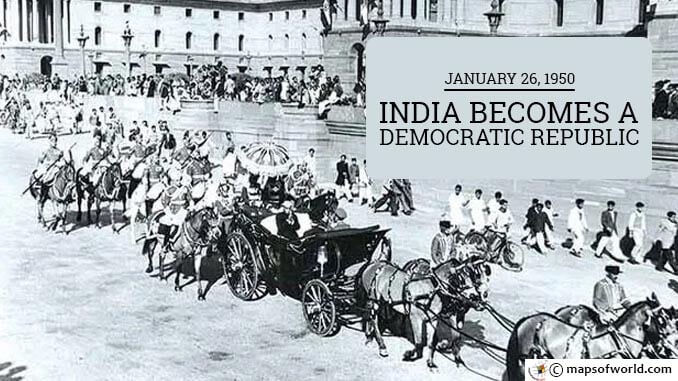On January 26, 1950, India adopted a new constitution, emerging from over a century of British rule, and became the Republic of India – the world’s most populous democratic nation. With the disintegration of the Mughal Empire in India, countries like France, Denmark, the Netherlands and Britain were drawn to the nation as a lucrative trading destination. The allure of spices, gold, and jewels gave way to colonization and by the mid-18th century, most of India had been annexed as part of the British Empire. India became a much coveted province of the British monarchy. Though the British faced much resistance from the early days of colonialism, the Indian independence movement gained a tremendous momentum in the second decade of the 20th century with the emergence of national leaders such as MK Gandhi. The formation of the Indian National Congress in 1885 provided the momentum necessary to propel the independence struggle to a crescendo. The INC united both conservative elements in favor of pacific negotiations and more radical aggressive leaders of the freedom struggle and Gandhi won them over with his ideals of truth, non-cooperation, and non-violence. By the 1940s it became apparent that days of the British rule in India were numbered. Representatives of the British government headed by Prime Minister Clement Attlee, the Viceroy of India, Lord Mountbatten, and representatives of the Indian National Congress, the Muslim League, and the Indian Sikh community headed to the negotiation table. India would gain independence but the country would not remain whole. Two independent dominions – the Dominion of India and the Dominion of Pakistan were set up by the Indian Independence Act of 1947. The Act received the assent of the British crown on July 18, 1947, and India became an independent nation on August 15 that year. The division of the Indian sub-continent along religious divides led to the bloodbath of the partition. The jubilation of a hard-won freedom gave way to the horrors of bloody carnage and a territorial dispute that would bring major wars and a history of hostility in the decades to come. Estimates of death due to partition range from 200,000 to 1,000,000. The leaders of India were now charged with a new responsibility – forming a cohesive union out of the country which had been fractured through history by the formation and dissolution of princely states. Leaders such as Sardar Vallabhbhai Patel and V. P. Menon worked hard to coax the rulers of various Indian princely states to accede to India. Colonial enclaves under the rule of France and Portugal were also brought under the rule of the central administration. For effective administration of such a vast country, however, it would be necessary to create a strong and comprehensive constitution. The Constituent Assembly of India was set up by the 1946 Cabinet Mission to India even while the country was under British rule. The Constituent Assembly members were elected by provincial assembly members. The Constituent Assembly had 217 representatives in all. The Constituent Assembly also formed the Interim Government of India on September 2, 1946. The drafting committee of the constitution was chaired by Dr B.R. Ambedkar. The committee presented a detailed draft constitution to the Assembly. The draft was then opened up for debate and discussion. At this stage a number of amendments were proposed and enacted. The constitution of India eventually turned out to be an expertly deliberated and drafted document – the longest written constitution of any sovereign country in the world. Currently it has 25 parts containing 448 articles, 12 schedules, 5 appendices and 98 amendments. Apart from the legislative procedures it details out the processes for formation of the government, electoral procedures and the rights and duties of the citizens of the country. It draws its virtues from various other constitutions and is an evolving document. The Constitution was finally adopted by the India Constituent Assembly on November 26, 1949. It was decided that the constitution would come into effect on January 26, 1950, since the date commemorated the declaration of Purna Swaraj (Complete Independence) as the goal of the freedom struggle in 1930. Thus on January 26, 1950, the Union of India officially became the Republic of India. A public holiday was declared throughout the country. Millions of Indians came out of home to celebrate. Processions were taken out and elaborate ceremonies marked the hoisting of the newly adopted flag. The first President of India, Dr Rajendra Prasad, took his oath at the capital – New Delhi. In his national address, Dr Prasad said, ”Today, for the first time in our long and chequered history we find the whole of this vast land… brought together under the jurisdiction of one constitution and one union which takes over responsibility for the welfare of more than 320 million men and women who inhabit it”. Following India’s first general elections, Jawaharlal Nehru took over as Prime Minister in 1952 and served three terms. Faced with a staggering population, extreme poverty, lack of education and employment, the early governments of the nation succeeded in solemnly upholding the constitution and in solidifying the republic. To this day, Republic Day celebrations held in India are some of the grandest festivities held in the country. The parade down Rajpath, in the capital of India, Delhi, is attended by many dignitaries from around the globe and viewed by millions in the country. You may also like : January 26 1952 – The Black Saturday Riots Occur on the Streets of Cairo
January 26 1950 – India becomes a Democratic Republic
On January 26, 1950, India adopted a new constitution, emerging from over a century of British rule, and became the Republic of India – the world’s most populous democratic nation.…
812
